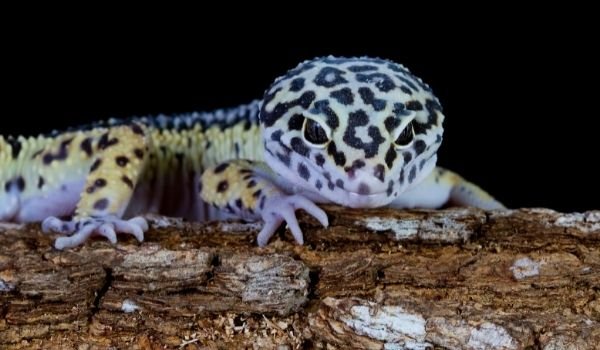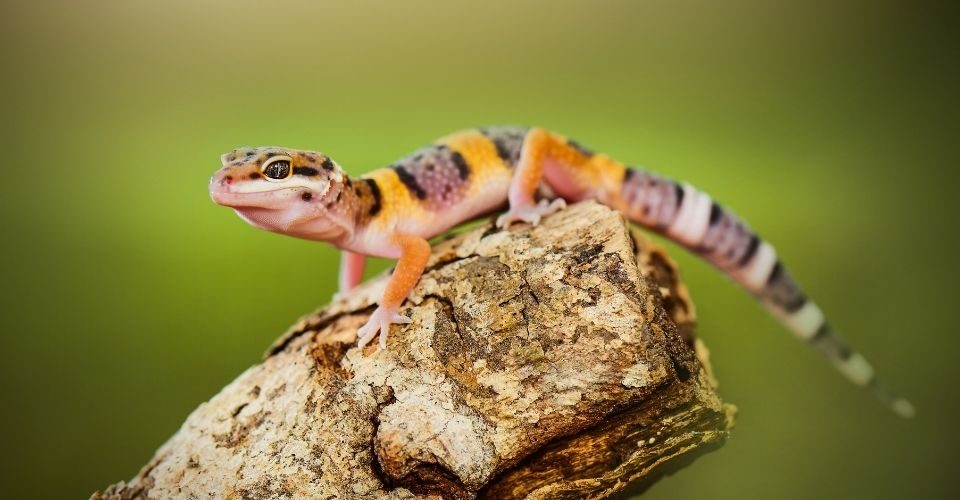Leopard geckos make excellent pets. They are found in deserts and arid grasslands of Pakistan, Afghanistan, northern India, western Iraq, and Iran. Although these hardy lizards are creatures of the night, they do care about what their day looks like.
New owners must have heard that leopard geckos are nocturnal and do not require much light, but it’s not true. In fact, while they need only heat at night, in the daytime, they need both. According to the studies, Leopard geckos as well as most other gecko species such as Leachie gecko, Satanic Leaf-tailed gecko, Mourning Gecko, and baby crested gecko, require a particular pattern of light and darkness to keep them healthy and make them feel at home.
Let’s shed some light on the lighting needs of Leopard geckos.
Do Leopard Gecko Need Light?
Yes, Leopard geckos require light in their enclosures.
A major misconception about Leopard gecko’s need for light or the lack of it is that they are nocturnal animals. That means they are active during the night and sleep during the day and thus, see little to no sun at all. This automatically deludes owners into assuming that they do not need lighting in their tanks. Unfortunately, it is not true. Light is essential for Leopard geckos to maintain the day and night cycle.
According to the facts, even when these geckos are sleeping all day, they are aware of their surroundings. They can tell the difference between days and nights as they depend on it for their survival. You might have seen your gecko heating its body in a basking spot. However, most Leopard geckos prefer not to bask in the direct light—they use residual heat by lying closer to the basking spot or going to the basking spot when the light is turned off.
Moreover, although it is widely believed that Leopard geckos are mostly nocturnal, it is not the case. They are more active at nightfall and daybreak and are thus being called crepuscular species. Their activities are highest at night, but it is not where it begins. This means that these lizards (yes, Leopard geckos are lizards) need a balanced day (lighting) and night (darkness) hours.
Let’s find out what is the best Leopard gecko lighting setup!
Best Leopard Gecko Lighting Setup

Leopard geckos are one of the most easy-going reptiles. But they come from a unique habitat, and it’s the responsibility of their owners to make sure that their tank setup exhibits their natural habitat and light cycles exhibit the natural day-night cycle of their natural environment. These pet reptiles need lighting and heating during the day and only heat at night.
Lighting at nighttime is not needed because that will deceive your gecko into thinking if it is still the day—which, in turn, would disturb its sleep and meal pattern.
Making the best Leopard gecko lighting setup is quite simple. Let’s dive into details!
How to Make the Best Leopard Gecko Lighting Setup?
Before placing your Leo in a tank, you should have a lighting and heating setup. You should also have control over the heat and humidity in the tank.
Use one side of the enclosure as the warm side. Place the heating elements like basking light directly above the tank rather than on the side and heating pad under the tank. This prevents bright lights from hurting your leopard gecko’s eyes. Normally, the heating elements on the warm side generate enough heat to keep the cool side at the right temperature. But tanks larger than 25 gallons can have a secondary, low-power heat source.
The cool side should not have heating elements, but it can have lights in case you are not using UV basking bulbs. You can use a fluorescent UV bulb or strip light that does not put off heat.
Most importantly, thermostats should be connected with the heater on the warm side of the enclosure. The thermostat will shut the heater off automatically if the temperatures get off-limits.
How Much Light Should Be Given to Leopard Gecko in a Day?
Given that Leopard geckos hail from desserts and arid grasslands of Asia, they try to copy the daylight patterns of their locale to make your gecko feel at home. This will help it to maintain the sleep cycle.
In summer
Your gecko requires 14 hours of daytime and 10 hours of nighttime.
In winter
Leopard Geckos require 12 hours of daytime and 12 hours of nighttime.
Do Leopard Gecko Need UVB?
Unlike most lizards, Leopard geckos do not necessarily need a UVB light as they are nocturnal and rarely come out of their hiding spots. Although many gecko keepers claim that UVB light has many health benefits to offer to Leopard geckos, there is no substantial evidence to support these claims.
While lizards need UVB light to synthesize their vitamin D, Leopard geckos get their vitamin D from the diet, and thus no special UVB light is required. Vitamin D3 helps geckos—the usual Leopard geckos, giant Leopard gecko, and all other Leopard gecko morphs such as Mack Snow Leopard gecko—absorb calcium and ward off the risk of metabolic bone disease and fractures. A safe amount of vitamin D3 is added to most commercially available calcium supplements.
You can coat insects with calcium supplements (containing vitamin D3) to meet the nutritional requirements of your gecko. You don’t need to provide supplements with every meal. You don’t even have to feed your leopard gecko daily—Leopard gecko can go as long as 2 weeks without food.
Even though geckos do not require UVB light to survive, given the plethora of discussions on the health benefits of UVB light for geckos, it is understandable if you want to get one for your leopard gecko lighting setup.
What is the Best Type of Light for a Leopard Gecko?
Usually, 5 to 6% UVB lights are perfect for Leopard geckos. The best option is to use made-for-reptiles lights as they are designed to output a controlled amount of light and UV radiation to the reptiles.
Mercury Bulbs
Most UV bulbs are fluorescent, but mercury vapor bulbs also emit UVB. They can emit light for two to three years, but they should be changed every 6 months. Care should be taken while using mercury bulbs as they emit a lot of heat. Mercury bulbs are good for bigger reptiles that require more heat than geckos. If you are using a mercury bulb for your gecko, then you must monitor the temperature in the tank using a thermostat.
Full Spectrum and Incandescent Bulbs
Full-spectrum lights are low in UVB, but they refer to the spectrum of visible lights. Moreover, you can also use household incandescent bulbs—they do not produce much UVB radiation, but then Leos don’t need much UVB.
Once you decide what type of light you want to use for your gecko, you need to consider two types of light fixtures: dome light and strip light.
Dome Light Fixtures
These fixtures concentrate light on a specific area. They can house an array of lights, from ceramic heat bulbs to basking bulbs and UVB. They are most helpful for heat spots and UVB rather than visible lights.
Strip Light Fixtures
They are more useful for full spectrum lights as they light up a larger area of the tank. They can also be used for incandescent and UV bulbs.
Leopard Gecko Day Light
Earlier, the tank light was considered to be a heat lamp for geckos because it was assumed that these hardy lizards do not need UV rays. However, in recent studies, it has been found that geckos need heat and light both in the day to maintain their day-night cycle. Let’s find out what is the best light to be used in the daytime.
Incandescent Day Light Bulbs
The standard incandescent tungsten or halogen bulbs will do fine for geckos as primary light sources. They emit only yellows and reds without blue parts of the spectrum most of the time.
The regular home incandescent of proper wattage will also be okay for geckos as well. However, there are also more refined incandescent daylights specifically made for reptiles.
Full-Spectrum Day Light Bulbs
You can use daylight fluorescent bulbs if you want something that does not produce UVB rays. But if you want to use UVB lights with your pet, go for something that outputs relatively little UVB.
Leopard Gecko Night Light
Nature has blessed Leos with great night vision; they do not need any light at night. However, you may want to watch your gecko, and you have no night vision, so you will have to use a night light to be able to see your gecko during the nighttime—when they are the most active. In such cases, red, blue and, black lights are used.
Keep in mind, these lights should never be kept on all night. They should be used only for two hours after turning off the daylight. Full darkness is crucial to keep your Leopard gecko happy and healthy.
Have a look at the pros and cons of each night light:
Blue Light
Just like moonlight, they give a blue glow and provide enough light to humans to watch their Leos at night. Despite being dark, these lights are visible to geckos, and this can interrupt their sleep cycle if used for more than two hours.
Red Light
This light gives off a warm and red glow. Like blue lights, leopard gecko’s night vision makes these lights brighter to them than us.
Black Light
These lights emit a purple glow via UVA light. Though the long-term effects of these lights on geckos are not well-known, it is better they are avoided.
Day/Night Light Combos
Some manufacturers offer a combination of day and night light for Leopard geckos at affordable rates with fixtures to house in them.
In case you find good quality combos, it is practical to purchase one as it would save the time and space required to install the fixtures.
Leopard Gecko Lighting Tips
Here are some tips for you to provide the best Leopard gecko lighting setup to your dear friend.
- The light should be placed directly above the enclosure and not on the sides to protect your gecko’s eyes.
- The light should not be placed inside the enclosure. Placing the lamp on the mesh lid will also be fine.
- Do not a use bulb that is too powerful for the size of your gecko’s tank.
- Set the lights at a distance of six inches from your pet. If your gecko can climb to the lid, in that case, the lamp should be hanging over the tank.
- Always check the temperature below the heat lamp.
- If your Leo can get near the heat lamp, use guards.
- Follow manufacturer instructions to learn how to use the bulbs.
- Provide hides and caves both on the light side and the darker side of the tank.
Conclusion
Now you know that daytime lighting is as important as nighttime light for the geckos. Heating and lighting can be provided through different combinations of lamps and heaters. However, the best lighting setup is the 5 UVB basking bulb, a 100W ceramic heat emitter. Temperature and light should be regulated via thermostat and time. Must follow the tips we have mentioned to keep your gecko’s habitat healthful and natural.
So, we have provided you with all the information about the best leopard gecko lighting setup. Now it is your turn to provide your geckos with the environment they like.





